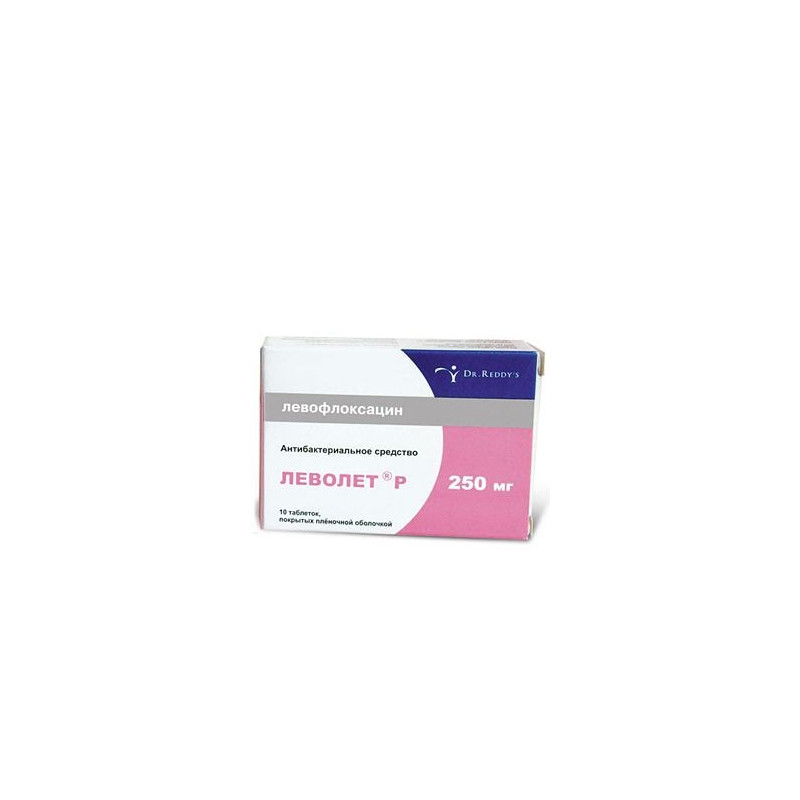



 All payments are encrypted via SSL
All payments are encrypted via SSL
 Full Refund if you haven't received your order
Full Refund if you haven't received your order
Levolet film-coated tablets:
1 tab. contains Levofloxacin hemihydrate 256.233 and 512.466 mg (equivalent to levofloxacin 250 and 500 mg, respectively);
Excipients: MCC (Avicel PH 101); corn starch; colloidal silicon dioxide; crospovidone; hypromellose (15 cps); MCC (Avicel PH 102); Magnesium stearate;
shell: Opadry dye white OY 58900 (hypromellose 5 cP, titanium dioxide, macrogol 400);
in the package 10 pcs.;
solution for infusion:
5 mg / ml contains 512 mg of levofloxacin hemihydrate (equivalent to 500 mg of levofloxacin);
Excipients: dextrose; hydrochloric acid; sodium hydroxide; water for injections;
in the PE bottle 100 ml.
Levolet has a broad spectrum bactericidal, antimicrobial effect.
Common to both dosage forms
Infectious and inflammatory diseases of mild and moderate severity caused by pathogens that are sensitive to the drug:
community-acquired pneumonia;
drug-resistant forms of tuberculosis (as part of complex therapy);
complicated infections of the kidneys and urinary tract, including pyelonephritis;
uncomplicated urinary tract infections;
prostatitis, incl. bacterial;
septicemia / bacteremia associated with the above indications;
intra-abdominal infection.
For film-pills (optional)
infections of LOR-organs (acute sinusitis);
lower respiratory tract infection (exacerbation of chronic bronchitis);
infections of the skin and soft tissues.
hypersensitivity to levofloxacin or other quinolones;
hypersensitivity to the auxiliary components of Levolet;
epilepsy;
tendon lesions associated with a history of quinolone;
children and adolescents up to 18 years;
pregnancy;
lactation period (breastfeeding).
Carefully:
advanced age (high probability of concomitant decline in renal function);
deficiency of glucose-6-phosphate dehydrogenase.
The frequency of side effects is classified depending on the frequency of occurrence: often (1–10%), sometimes (less than 0.1–1%), rarely (0.01–0.1%), very rarely (less than 0.01% ), including individual messages.
On the part of the blood system and the blood-forming organs: sometimes - eosinophilia, leukopenia; rarely - neutropenia, thrombocytopenia; very rarely - pronounced agranulocytosis; in some cases - hemolytic anemia, pancytopenia.
From the digestive system: often - nausea, diarrhea, increased activity of ALT, ACT, dysbiosis; sometimes - loss of appetite, vomiting, abdominal pain, digestive disorders, hyperbilirubinemia; rarely, diarrhea mixed with blood (in very rare cases it may be a sign of inflammation of the intestine or pseudomembranous colitis); very rarely - hepatitis.
Cardiovascular: rarely - tachycardia, lowering blood pressure; very rarely - vascular collapse; in some cases - prolongation of the QT interval.
From the central and peripheral nervous system: sometimes - headache, dizziness, stiffness of movement, drowsiness, sleep disturbance; rarely - paresthesias in the hands, tremors, anxiety, states of fear, seizures, convulsions, confusion; very rarely - psychotic reactions such as hallucinations and depressions, movement disorders.
From the senses: very rarely - impaired vision and hearing, smell, taste and tactile sensitivity.
Metabolism: very rarely - hypoglycemia (manifested by a sharp increase in appetite, nervousness, sweat, tremors); in some cases - the aggravation of the existing porphyria.
On the part of the urinary system: rarely - hypercreatininemia; very rarely - deterioration of renal function up to acute renal failure (for example, due to allergic reactions - interstitial nephritis).
Musculoskeletal system: rarely - lesions of tendons (including tendonitis), joint and muscle pain; very rarely - tendon ruptures (including Achilles, which can be bilateral and occur within 48 hours after the start of treatment), muscle weakness (is of particular importance for patients with myasthenia); in some cases - rhabdomyolysis.
Allergic reactions: sometimes - itching and redness of the skin; rarely - anaphylactic and anaphylactoid reactions (manifested by symptoms such as urticaria, bronchospasm and possible severe choking, and in rare cases - swelling of the face, larynx); very rarely - a sharp decrease in blood pressure, anaphylactic shock; in some cases - Stevens-Johnson syndrome,toxic epidermal necrolysis (Lyell's syndrome) and exudative erythema multiforme, allergic pneumonitis, vasculitis.
Dermatological reactions: very rarely - photosensitivity.
Other: sometimes - asthenia; very rarely - persistent fever, development of superinfection.
Local reactions (for solution for infusions additionally): often - pain, redness, phlebitis.
Levolet is applied inside, in / in.
Doses are determined by the nature and severity of the infection, as well as the sensitivity of the suspected pathogen.
For film-coated tablets
Inside, to food or in a break between meals, without chewing, drinking plenty of liquid.
Sinusitis: 500 mg 1 time per day. The course of treatment is 10-14 days.
Exacerbation of chronic bronchitis: 250–500 mg 1 time per day. The course of treatment is 10-14 days.
Infections of the skin and soft tissues: 250 mg 1–2 times per day or 500 mg 1 time per day. The course of treatment is 7-14 days.
For both dosage forms
Community-acquired pneumonia: 500 mg 1-2 times a day. The course of treatment is 7-14 days.
Uncomplicated urinary tract infections: 250 mg 1 time per day. The course of treatment is 3 days.
Complicated urinary tract infections (including pyelonephritis): 250 mg 1 time per day. The course of treatment is 7–10 days.
Prostatitis, incl. bacterial (solution for infusion): 500 mg 1 time per day. The course of treatment is 28 days.
Septicemia / bacteremia: 500 mg 1-2 times a day. The course of treatment is 10-14 days.
Intraabdominal infection: 500 mg 1 time per day. The course of treatment is 7–14 days, in combination with antibacterial drugs acting on the anaerobic flora.
In the complex therapy of drug-resistant forms of tuberculosis: 500 mg 1–2 times a day (500–1000 mg of levofloxacin per day), depending on the severity of the disease and the treatment regimen used. The course of treatment is up to 3 months.
Store in a cool and dark place, protected from light and moisture, at a temperature not higher than 25 ° C.
